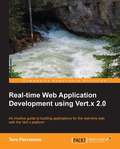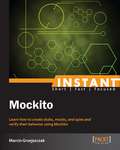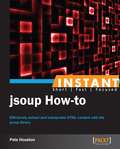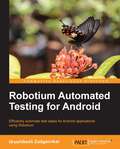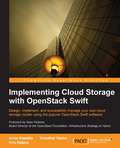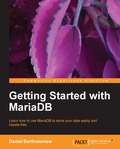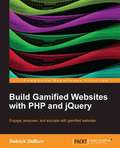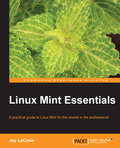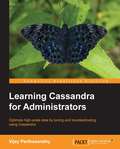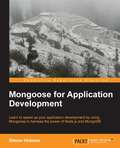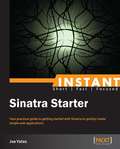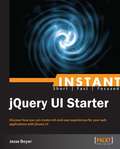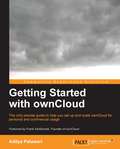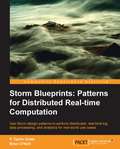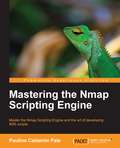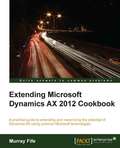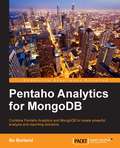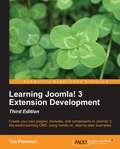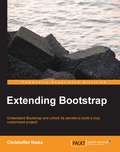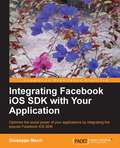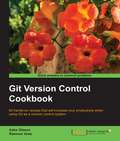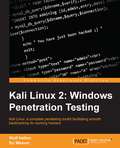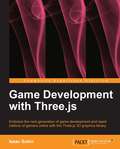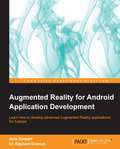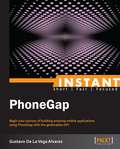- Table View
- List View
Real-time Web Application Development using Vert.x 2.0
by Tero ParviainenA quick, clear, and concise tutorial-guide-based approach that helps you to develop a web application based on Vert.x.Real-time Web Application Development with Vert.x is written for web developers who want to take the next step and dive into real-time web application development.This book uses JavaScript (and some Java) to introduce the Vert.x platform, so basic JavaScript knowledge is expected. If you're planning to write your applications using some of the other Vert.x languages, all the techniques and concepts will translate to them directly. All you need to do is refer to the Vert.x API reference documentation to see the particular APIs for your language.
Instant Mockito
by Marcin GrzejszczakFilled with practical, step-by-step instructions and clear explanations for the most important and useful tasks. This is a standard, tutorial-based guide using plenty of examples for illustration.Instant Mockito is ideal for developers new to unit testing, who are looking to get to know how to create high quality tests using Mockito. It's assumed that you will have some experience in Java already.
Instant jsoup How-to
by Pete HoustonFilled with practical, step-by-step instructions and clear explanations for the most important and useful tasks. This book will take a how-to approach, focusing on recipes that demonstrate Jsoup.If you are working in data scraping, data crawling, or within a similar area using Java, then this book is the one for you. This book acts as a fast-paced and simple guide to enhance your HTML data manipulating skills using one of the most well-known libraries, Jsoup.
Robotium Automated Testing for Android
by Hrushikesh ZadgaonkarThis is a step-by-step, example-oriented tutorial aimed at illustrating the various test scenarios and automation capabilities of Robotium.If you are an Android developer who is learning how to create test cases to test their application, and are looking to get a good grounding in different features in Robotium, this book is ideal for you. It's assumed that you have some experience in Android development, as well be familiar with the Android test framework, as Robotium is a wrapper to Android test framework.
Implementing Cloud Storage with OpenStack Swift
by Sreedhar Varma Kris Rajana Amar KapadiaThis tutorial-based book has a step-by-step approach for each topic, ensuring it is thoroughly covered and easy to follow. If you are an IT architect or administrator who wants to enter the world of cloud storage using OpenStack Swift, then this book is ideal for you. Whether your job is to build, manage, or use OpenStack Swift, this book is an excellent way to move your career ahead.
Getting Started with MariaDB
by Daniel BartholomewA practical, hands-on, beginner-friendly guide to installing and using MariaDB.Getting Started with MariaDB is for anyone who wants to learn more about databases in general or MariaDB in particular. No prior database experience is required. It is assumed that you have basic knowledge of software installation, editing files with a text editor, and using the command line and terminal.
Build Gamified Websites with PHP and jQuery
by Detrick DeburrThis book is a standard tutorial, which walks you through the gamification development process, to help you incorporate game elements in an eLearning environment.This book is for jQuery and PHP developers who wish to gamify their educational websites.
Linux Mint Essentials
by Jay LacroixA task-oriented look at Linux Mint, using actual real-world examples to stimulate learning. Each topic is presented in an easy-to-follow order, with hands-on activities to reinforce the content. If you are starting out with Linux from a different platform or are well versed with Linux Mint and want a guide that shows you how to exploit certain functionality, this book is for you. No previous Linux experience is assumed.
Learning Cassandra for Administrators
by Vijay ParthasarathyThis book is a practical, hands-on guide, taking the reader from the basics of using Cassandra though to the installation and the running.Learning Cassandra for Administrators is for administrators who manage a large deployment of Cassandra clusters, and support engineers who would like to install the monitoring tools and who are also in charge of making sure the cluster stays the same, ensuring that the service is always up and running.
Mongoose for Application Development
by Simon HolmesThis book is a mini tutorial full of code examples and strategies to give you plenty of options when building your own applications with MongoDB.This book is ideal for people who want to develop applications on the Node.js stack quickly and efficiently. Prior knowledge of the stack is not essential as the book briefly covers the installation of the core components and builds all aspects of the example application. The focus of the book is on what Mongoose adds to you applications, so experienced Node.js developers will also benefit.
Instant Sinatra Starter
by Joe YatesGet to grips with a new technology, understand what it is and what it can do for you, and then get to work with the most important features and tasks. Written as a practical guide, Instant Sinatra Starter will help you create a simple web app in no time at all.Instant Sinatra Starter is great if you are looking to get started with Sinatra for web development. Some previous experience with Ruby would be beneficial though not necessary for this step-by-step exploration of Sinatra and the world of web development.
Instant jQuery UI Starter
by Jesse BoyerGet to grips with a new technology, understand what it is and what it can do for you, and then get to work with the most important features and tasks.A quick and easy-to-follow book on jQuery UI, it's is packed with the features of jQuery UI that you need to know to enhance your web applications.This book is aimed at people who have heard about jQuery UI but don't feel like they've had a thorough introduction.
Getting Started with ownCloud
by Aditya PatawariThis is a standard, precise, and short tutorial for setting up ownCloud and includes advanced topics like encryption, user management, and server security. This ownCloud book would be an ideal starting point for anyone who wants to store their data and also share it.This book is for first time users as well as administrators who are interested or responsible for managing an ownCloud instance. You do not need any prior experience with any of the technology, including Linux/Windows, Apache/IIS, SQLite/MySQL, or even PHP. It is a beginner-friendly book, written with a first time user in mind.
Storm Blueprints: Patterns for Distributed Real-time Computation
by Brian O'Neill P. Taylor GoetzA blueprints book with 10 different projects built in 10 different chapters which demonstrate the various use cases of storm for both beginner and intermediate users, grounded in real-world example applications. Although the book focuses primarily on Java development with Storm, the patterns are more broadly applicable and the tips, techniques, and approaches described in the book apply to architects, developers, and operations. Additionally, the book should provoke and inspire applications of distributed computing to other industries and domains. Hadoop enthusiasts will also find this book a good introduction to Storm, providing a potential migration path from batch processing to the world of real-time analytics.
Mastering the Nmap Scripting Engine
by Paulino Calderon PaleIf you want to learn to write your own scripts for the Nmap Scripting Engine, this is the book for you. It is perfect for network administrators, information security professionals, and even Internet enthusiasts who are familiar with Nmap.
Extending Microsoft Dynamics AX 2012 Cookbook
by Murray FifeFollow valuable and practical recipes touring the fundamental features of Dynamics AX extension.This title is for business professionals, such as administrators and consultants, who want to take full advantage of the features of Dynamics AX. This book has a wide appeal and you do not need to be a SharePoint, database or programming expert. As long as you know a little about these elements, you will be able to take full advantage of the business efficiency created with Dynamics AX extensions.
Pentaho Analytics for MongoDB
by Bo BorlandThis is an easy-to-follow guide on the key integration points between Pentaho and MongoDB. This book employs a practical approach designed to have Pentaho configured to talk to MongoDB early on so that you see rapid results. This book is intended for business analysts, data architects, and developers new to either Pentaho or MongoDB who want to be able to deliver a complete solution for storing, processing, and visualizing data. It's assumed that you will already have experience defining data requirements needed to support business processes and exposure to database modeling, SQL query, and reporting techniques.
Learning Joomla! 3 Extension Development-Third Edition
by Tim PlummerA practical guide with step-by-step examples that build on each other so you can learn by doing and get hands-on knowledge about creating your plugins, modules, and components in Joomla."Learning Joomla! 3 Extension Development, Third Edition" is for developers who want to create their own Joomla extensions. It is assumed you will have some basic PHP, HTML, and CSS knowledge, but you don't need any prior Joomla programming experience. This book will also be useful to people who just want to make minor customizations to existing Joomla extensions and build on the work of others in the open source spirit.
Extending Bootstrap
by Christoffer NiskaPractical and instruction-based, this concise book will take you from understanding what Bootstrap is, to creating your own Bootstrap theme in no time! If you are an intermediate front-end developer or designer who wants to learn the secrets of Bootstrap, this book is perfect for you.
Integrating Facebook iOS SDK with Your Application
by Giuseppe MacrìA tutorial-based guide with chapters focusing on learning and embedding crucial Facebook features.If you are a developer who wishes to develop and monetize your apps on the App store, then this is the book for you. This book assumes you have basic knowledge of iOS programming using Objective-C and XCode, however, prior knowledge of Facebook iOS SDK is not required.
Git Version Control Cookbook
by Aske Olsson Rasmus VossThis practical guide contains a wide variety of recipes, taking you through all the topics you need to know about to fully utilize the most advanced features of the Git system. If you are a software developer or a build and release engineer who uses Git in your daily work and want to take your Git knowledge to the next level, then this book is for you. To understand and follow the recipes included in this book, basic knowledge of Git command-line code is mandatory.
Kali Linux: Windows Penetration Testing
by Bo Weaver Wolf HaltonIf you are a working ethical hacker who is looking to expand the offensive skillset with a thorough understanding of Kali Linux, then this is the book for you. Prior knowledge about Linux operating systems and the BASH terminal emulator along with Windows desktop and command line would be highly beneficial.
Game Development with Three.js
by Isaac SukinA step-by-step, example-based guide to building immersive 3D games on the Web using the Three.js graphics library.This book is for people interested in programming 3D games for the Web. Readers are expected to have basic knowledge of JavaScript syntax and a basic understanding of HTML and CSS. This book will be useful regardless of prior experience with game programming, whether you intend to build casual side projects or large-scale professional titles.
Augmented Reality for Android Application Development
by Jens Grubert Dr Raphael GrassetA step-by-step tutorial-based guide aimed at giving you hands-on practical experience to develop AR applications for Android.Augmented Reality for Android Application Development is for Android mobile application developers who are familiar with Android Development Tools and deployment, JMonkeyEngine, and the Vuforia SDK.
Instant PhoneGap
by Gustavo De AlvarezGet to grips with a new technology, understand what it is and what it can do for you, and then get to work with the most important features and tasks. This is a guide that starts with the basics of a PhoneGap mobile application along with top features to enable you to build your own PhoneGap mobile application.This book is ideal for those who want to develop mobile apps but do not want to learn a new SDK for every phone on the shelf. You should have basic knowledge of HTML5, JavaScript, and CSS or any programming language.
